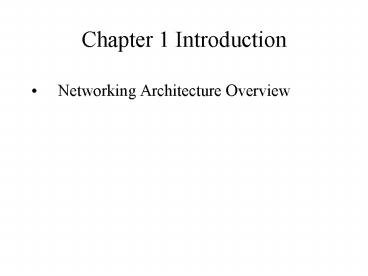Chapter 1 Introduction PowerPoint PPT Presentation
1 / 10
Title: Chapter 1 Introduction
1
Chapter 1 Introduction
- Networking Architecture Overview
2
Networking Architecture Overview
- A Generic Network
- node switch/router
- end-host telephone/computer/server
- More intelligent at the edge nodes
- Higher speed at the core nodes
edge node
core node
end-host
3
Networking Architecture Overview
- It is all about how to send
information/packets between end-hosts - Routing Protocol
- Build the network topology/map
- Find one or multiple routes/paths from any node
to any other nodes - Build a routing/forwarding table
- Two forwarding paradigms
- Connection-oriented set up a virtual path and
forward packets along the path - Connectionless forward packets and let each node
downstream figure out how to forward the packets
further downstream, known as hop-by-hop
forwarding
4
Networking Architecture Overview
- More on forwarding paradigms
- Connection-oriented
- Build the network topology through a routing
protocol each node tells its neighbors about its
connectivity by flooding - Based on the destination end-hosts global
address, the routing protocol in the first-hop
node finds a route/path to the last-hop node,
e.g., a shortest path - The first-hop node uses a signaling protocol to
install state information along the path. The
state information include incoming and out-going
labels with local significance (known as label
swapping table) and resources reserved for the
path. - The information is sent in the form of labeled
packets. At each intermediate node, the incoming
label in the packet is matched against the label
swapping table to find the outgoing label and
output interface to the downstream node. - The incoming label is replaced by the outgoing
label before the packet is sent to the output
interface downstream, known as label swapping.
5
Networking Architecture Overview
- More on forwarding paradigms
- Connectionless
- Build the network topology through a routing
protocol each node tells its neighbors about its
connectivity by flooding every node finds a path
to every other node and for each destination
node, record only the next-hop node along the
path to the destination node, resulting in a
destination-node-to-next-hop-node mapping table,
known as routing/forwarding/longest prefix match
(LPM) table. More on LPM later - The information is sent in the form of packets
with destination hosts global address attached - At each intermediate node, the destination hosts
global address is matched against the LPM table
to find the next-hop node and the packet is sent
to the next-hop node
6
Networking Architecture Overview
- IP internetworking basics Networks
- Shared medium broadcast domain
- e.g., Ethernet and token ring
- Use MAC (multiple access control) address to
forward frames, known as layer 2 forwarding - Point-to-Point
- e.g., packet over SONET (POS)
7
Networking Architecture Overview
- IP Internetworking is connectionless
- To go from one IP network to another, hop-by-hop
forwarding based on the destination IP address is
performed, known as layer 3 forwarding
one hop
8
Networking Architecture Overview
- Layering concept and addressing schemes
- Internet protocols are designed in layers the
lower layer provides service to its immediate
upper layer
Application
L5
Transport
L4
Internetworking
L3
Data link/MAC
L2
PHY
L1
9
Networking Architecture Overview
- Addressing schemes
- Local address
- VPI/VCI
- MPLS labels
- Layer 2/MAC address
- A global 48-bit flat address
- Cannot scale to large networks
- Layer 3/IP address
- A global 32-bit two layer hierarchical address
network part and host part
Network address host address
10
Networking Architecture Overview
- Two level routing hierarchies
- Intradomain OSPF, IS-IS, and RIP
- Interdomain BGP
- LPM select the one with the largest number of
matched bits
interdomain
intradomain
2.2.3.
2.2.2.2
2.2.2.

